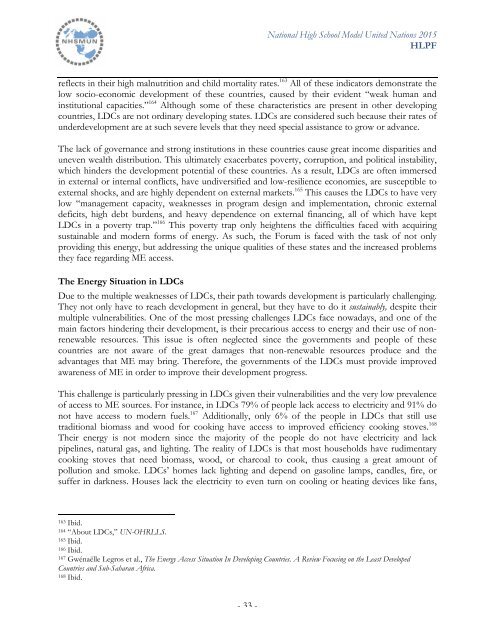d5MrHv
d5MrHv
d5MrHv
You also want an ePaper? Increase the reach of your titles
YUMPU automatically turns print PDFs into web optimized ePapers that Google loves.
National High School Model United Nations 2015<br />
HLPF<br />
reflects in their high malnutrition and child mortality rates. 163 All of these indicators demonstrate the<br />
low socio-economic development of these countries, caused by their evident “weak human and<br />
institutional capacities.” 164 Although some of these characteristics are present in other developing<br />
countries, LDCs are not ordinary developing states. LDCs are considered such because their rates of<br />
underdevelopment are at such severe levels that they need special assistance to grow or advance.<br />
The lack of governance and strong institutions in these countries cause great income disparities and<br />
uneven wealth distribution. This ultimately exacerbates poverty, corruption, and political instability,<br />
which hinders the development potential of these countries. As a result, LDCs are often immersed<br />
in external or internal conflicts, have undiversified and low-resilience economies, are susceptible to<br />
external shocks, and are highly dependent on external markets. 165 This causes the LDCs to have very<br />
low “management capacity, weaknesses in program design and implementation, chronic external<br />
deficits, high debt burdens, and heavy dependence on external financing, all of which have kept<br />
LDCs in a poverty trap.” 166 This poverty trap only heightens the difficulties faced with acquiring<br />
sustainable and modern forms of energy. As such, the Forum is faced with the task of not only<br />
providing this energy, but addressing the unique qualities of these states and the increased problems<br />
they face regarding ME access.<br />
The Energy Situation in LDCs<br />
Due to the multiple weaknesses of LDCs, their path towards development is particularly challenging.<br />
They not only have to reach development in general, but they have to do it sustainably, despite their<br />
multiple vulnerabilities. One of the most pressing challenges LDCs face nowadays, and one of the<br />
main factors hindering their development, is their precarious access to energy and their use of nonrenewable<br />
resources. This issue is often neglected since the governments and people of these<br />
countries are not aware of the great damages that non-renewable resources produce and the<br />
advantages that ME may bring. Therefore, the governments of the LDCs must provide improved<br />
awareness of ME in order to improve their development progress.<br />
This challenge is particularly pressing in LDCs given their vulnerabilities and the very low prevalence<br />
of access to ME sources. For instance, in LDCs 79% of people lack access to electricity and 91% do<br />
not have access to modern fuels. 167 Additionally, only 6% of the people in LDCs that still use<br />
traditional biomass and wood for cooking have access to improved efficiency cooking stoves. 168<br />
Their energy is not modern since the majority of the people do not have electricity and lack<br />
pipelines, natural gas, and lighting. The reality of LDCs is that most households have rudimentary<br />
cooking stoves that need biomass, wood, or charcoal to cook, thus causing a great amount of<br />
pollution and smoke. LDCs’ homes lack lighting and depend on gasoline lamps, candles, fire, or<br />
suffer in darkness. Houses lack the electricity to even turn on cooling or heating devices like fans,<br />
!!!!!!!!!!!!!!!!!!!!!!!!!!!!!!!!!!!!!!!!!!!!!!!!!!!!!!!!!!!!<br />
163 Ibid.<br />
164 “About LDCs,” UN-OHRLLS.<br />
165 Ibid.<br />
166 Ibid.<br />
167 Gwénaëlle Legros et al., The Energy Access Situation In Developing Countries. A Review Focusing on the Least Developed<br />
Countries and Sub-Saharan Africa.<br />
168 Ibid.<br />
- 33 -


